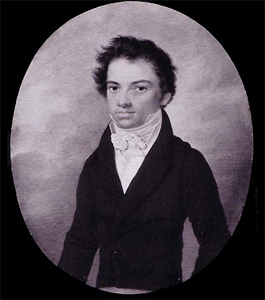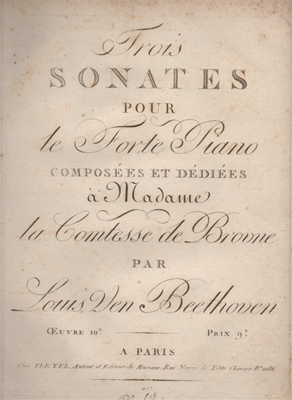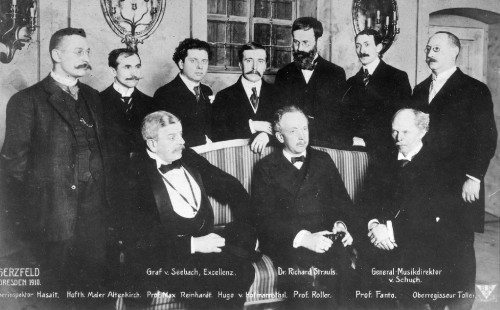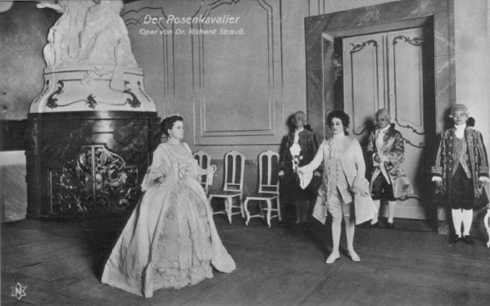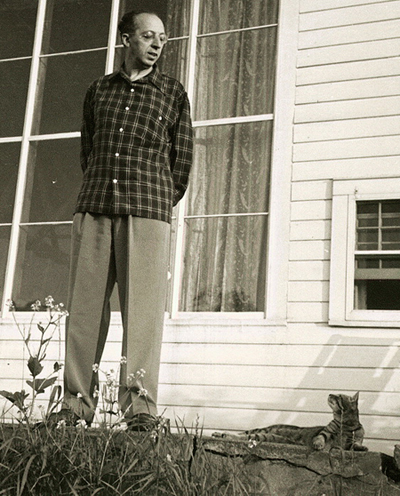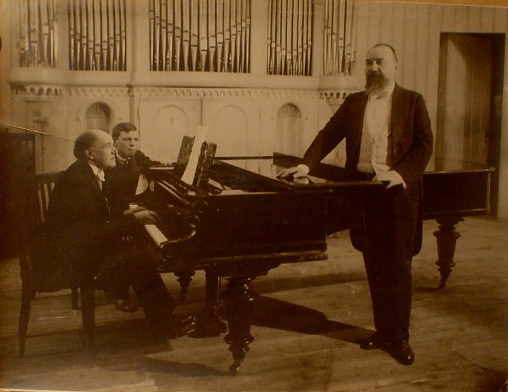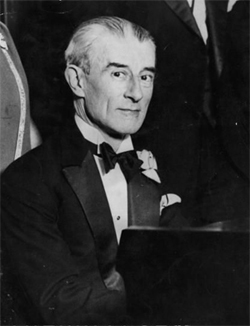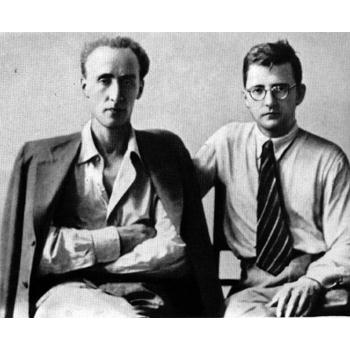Vincent d’Indy (1851–1931)
Symphonie sur un chant montagnard français (Symphonie cévenole), op. 25
composed: 1886 (age 35)
first performance: Paris, March 20, 1887 (Marie Bordes-Pène, Orchestre de Concerts Lamoureux/Charles Lamoureux?)
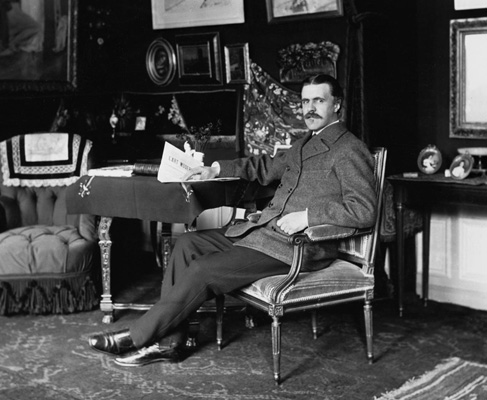
I don’t have the date of this photograph but based on other dated photos, he looks to be about the right age here. The headline on his newspaper says “L’Art Moderne,” which is pretty cool. Though it does seem likely that either he or the photographer rigged that up on purpose.
#13:
475.
1. The fact of this piece being on the “Essential Canon” list.
When the Medtner concerto came around, I said “If nobody knows a piece, it’s definitionally not in the Essential Canon, quality be damned,” and I stand by that. But in this case, though the quality of the piece may in fact be lower, I have more sympathy for the inclusion of an obscure work, because there was a time when it wasn’t obscure.
Monsieur d’Indy does not make even a single appearance in the 1001 Recordings list, and recordings of his works — not to mention performances — are truly few and far between. Even in this, the Era of The Long Tail, d’Indy manages to be decidedly obscure. And yet I’m almost certain that his was one of the lucky names on the “timeline of classical music” poster that my piano teacher had on the wall. Almost every classical musician knows that Vincent d’Indy is a famous composer — but nobody knows his music. How can this be?
A strange thing about classical music culture — about any “museum” culture — is that because it’s all about the past, there’s no clear criterion for what’s obscure and what’s mainstream, despite the fact that these concepts are central to the way the subject is discussed. As I said the other day, Wozzeck is obscure if you’re asking the population at large, but it’s mainstream if you’re asking people who are into classical music. (Heck, Don Giovanni is obscure if you’re asking the population at large.) L’incoronazione di Poppea is obscure if you are asking people who aren’t into pre-baroque music, mainstream if you’re asking people who are. But this starts to get silly. If you’re into Johannes Ockeghem (d. 1497), the Missa prolationum is totally mainstream.
The only reason I’ve heard of the pieces just mentioned is because they’ve been included in histories I’ve read, which means that someone thought they were relevant from a historian’s perspective. They are thus “mainstream” for music students. But this has all become a sort of an abuse of the concept of “mainstream.” Whatever Missa prolationum is to me — mainly: something that I’ve heard of — it’s certainly different from being essential to me, or culturally prevalent in the present day. (Of course, no classical music is actually prevalent in the present day — except for Carmina Burana and Flight of the Valkyries). The problem is that the distinction has been blurred between history and culture. Which, as I’ve said elsewhere, hasn’t been good for culture.
The question is, what does it really mean to claim that something is canonical? Is it a claim about the current consensus, the past consensus, or (what it usually seems to be) a claim about what the consensus should be and would be, if only we weren’t living in such benighted times?
At [the very old, very monied American university I attended], there is a concert hall built around 1914, in which a hall-of-fame of inscribed composers’ names runs overhead. The list is rigged so that the composers appear in approximate chronological order, but also so that HAYDN MOZART BEETHOVEN SCHUBERT CHOPIN fall directly over the stage. We students occasionally poked fun at this frieze for its irritating, inflated implication that “this is a temple and these are its gods” — but most of the snickering was reserved for the fact that the list ended with “… TSCHAIKOWSKY FRANCK BRAHMS.” Franck, eh? We would chuckle about how the smug old-schoolery of 1914 had shot itself in the foot: Franck, it had become clear in the intervening century, does not belong in that company, not at all. Who listens to Franck anymore? And who really likes it when they do?
Probably the unlucky person who had to come up with the list of names back in 1914 figured that Franck, who’d been as dead and adulated as Brahms and Tchaikovsky for more than 20 years, was a safe bet as an all-time great because he had followers (Chausson and, in particular, d’Indy, who was still alive and going strong), and followers mean a future. The “Franck school” would surely continue to be seen as the great turn-of-the-century movement in French music. Debussy had his admirers, sure, but where could that kind of gimmicky experimental stuff really lead? Besides, inscribing a living composer’s name on the walls of the temple would be sacrilege; it would demean the frieze by associating it with actual, flawed human beings.
So Franck’s name went up on the wall. But then, of course, starting just minutes after the gold leaf was set, the 20th century took culture by the hair and swung it around a few times until its neck was good and broken. In the process, all kinds of bits and pieces went flying into oblivion, and the Franck school, sadly, was among them. Even now, almost 100 years later, the scavenger hunt to pick up all the scattered fragments (and make them available for download) still hasn’t completely located the remains of Vincent d’Indy.
So: is d’Indy in this list because if it weren’t for the flaying of the canon (1914–1989) he might well still be in it? Or is he just in this list because historical music is music history, and music history tells us that Vincent d’Indy was, in his day, a prominent composer? I think the latter, but I am sympathetic to the logic of the former.
If any piece of d’Indy’s ever looked like it was going to make it into orbit, it was this symphony, which apparently maintained a place in the third-tier repertoire rotation well into the 20th century. It may even still have had some life in it after World War II, at least among French conductors. But at some point it finally bowed out. Rest in peace, Vincent d’Indy’s greatness.
But lo, what’s this? Culture’s skin has been stitched back on, its broken neck repaired with a couple of bolts, the corpse zapped with some kind of eerie blue lightning, and now it breaks free from its restraints and lumbers about — alive! Alive! It’s come back from the dead! “ME POST-POST-MODERN!!!” it bellows. “ME LOVE ART!!! ALSO SUSTAINABLE AGRICULTURE!!!! AND IPHONE!!!! ALSO GAUGIN!!! AND HONEYMOONERS!!! VINCENT D’INDY KIND OF AMAZING!!!! ALSO MORTON FELDMAN!!! AND MOZART!!! NEW STAR TREK MOVIE GOOD TOO!!! OMG YOU MUST TRY SPIDER ROLL!!! WHERE YOU WANT TO GO TODAY????”
Doesn’t it bring tears of joy to your eyes, to know that our long cultural nightmare is over?
2. This piece itself.
Admirable but flawed. Its flaws — “quirks” might be a kinder term — are a part of the same personality that gives it its appeal, and couldn’t be edited out if you tried. Like a sculpture made of pockmarked, pitted stone; if it had been carved of some smoother, more delicate stuff, it would have to be a different shape and would create a different impression: it would become some other work. This work is pockmarked and how could it be otherwise? The form and texture and substance create a sense together, and they share, among them, an imperfectness.
That in itself puts limits on how prominent this piece might ever become; it is an “interesting” piece and thus will always be off the most beaten path.
The piece is something of an experiment in instrumentation; it tries to incorporate the piano into the orchestral texture in a role that is prominent but several notches less so than in a concerto. I’m not particularly impressed with M. d’Indy’s accomplishment in this regard. He mostly seems to use the piano as though it were a loud harp, which isn’t really what it is. The percussive quality of the attacks isn’t really taken into aesthetic account, I don’t think, and many of his devices just don’t read well at all — like the instrument’s first entrance, where it bubbles out of the depths, thoroughly muddying the bass melody it’s supposed to color. Too much of the piano part, in my opinion, is standard filigree: arpeggio, scale, and repeated-note business, which no doubt requires careful practice but isn’t particularly interesting to the player, the composer, or the listener. The burden is really on the conductor, in this piece, to make the meaning and sense come to the fore.
And the sound engineer. The orchestration is full of odd colorful touches, but the intricacies are inconsistent and not always well-judged. A good deal of it gets swallowed up and ends up just sounding mushy, at least on the several recordings I was able to find. But it’s possible that some recording studio cheats to isolate the instruments could turn the piece into a delightful, flowering soundscape, which is how I bet Vincent imagined it.
The piece takes a “naïve” outdoorsy folk tune — it sounds like Hobbit music to me — and derives some of the material in each movement from it, audibly and directly. The symphony is also, as a whole, an attempt to do justice to the mountain-dwelling, nature-basking, stream-rippling spirit of the tune. On the most superficial level, this means sparkling waterfall arpeggios in the first movement, pastoral repose in the second movement, and bounding rabbits or something in the third movement. These sorts of things feel pretty stock, and in some ways, all the busy learnedness of the symphony pales next to the touching naïveté of the simple tune it is struggling to emulate and magnify. The tune is heard naked in the opening measures, and they’re probably the most memorable part of the whole piece.
But there is definitely a touch of beauty threaded through the work. It’s a little elusive, but there is something sensitive and real in there. And yes, it — whatever it is, down there in the poetic subconscious — has something to do with being out in the fresh air on a mountain. The piece is fluid but not limp; it has purpose. Quietly. That took some familiarity for me to hear.
The first movement is based on a proud-sounding “this fresh air does wonders for the constitution” type theme with a strong contour (up, then down!) but unfortunately no particular melodic outline to speak of — and then a nice flowing-grace-and-lightness 2nd theme very much a la Saint-Saëns. I have warmed to both of these, but the introductory ur-theme is still more effective than either.
The second movement is the best. The melody is lyrical and songlike but spun out in irregular conversational phrases; poetry in a flexible meter. This is where d’Indy comes the closest to achieving something of his own in the flavor of the folk tune. The chromatic B theme falls nicely in between fairy-tale and genuine uneasiness. On the first few listens, I thought I could do without the bombastic recapitulation, but having gotten to know it better, I see that it’s not so confident as it seems (the snaky second theme is lurking under it) and I’ve come to enjoy the whole course of the movement. I also like the watery pool where the movement finally slows to a stop: the sparkles that close the movement are in a sense completely gratuitous, and that’s what makes them particularly vivid for me.
The third movement is built over a bouncy diminution of the main melody, which never fails to sound lame to me, but the swooning second theme is pretty catchy 19th-century-style, and once the march-of-the-dwarfs-y snippet of movement 2 appears, the whole ending is peculiar good fun.
In the coda (around rehearsal letters U through X) there’s a metrical eccentricity. A new condensed version of the melody is heard in 8th notes, first in 2/4 and later in 3/8. In between, it’s heard twice as 6 bars of 3/8 plus 1 bar of 2/4. Over this, the composer writes “Même mouvement. (Les croches conservent toujours la même valeur.)” In other words, the 8th notes are constant. If performed that way, as written, there is a fun juxtaposed-meter effect, where the melody from the 2/4 section continues to recur, but the accompaniment begins to syncopate playfully against it, in 3/8. The single inserted bar of 2/4 is a temporary reconciliation between the two elements, but eventually the new 3/8 feeling wins over. This is catchy and propulsive and leads very satisfyingly to the climax.
But in all 4 of the recordings I heard, performed by people who should most certainly have known better, instead of keeping the 8th notes constant as requested explicitly on the page, the conductors keep the bars constant through the meter change, which means that when it launches into 3/8, there’s just a relaxed triplet feeling, and the 2/4 insertions come off as either a hiccup or a place where the record skips — which is a weird and intriguing effect, but clearly not the one d’Indy had in mind. Why would there be a hiccup in the music at that point? That obviously doesn’t make any sense! And yet Charles Munch and Paul Paray just forge ahead. I found this bewildering.
I mean, am I crazy? Those guys probably knew what they were doing, right? Even though it sounds bizarre, and even though it says something else in the score? I think niceties of rhythm and meter just weren’t top priorities for several generations of musicians. I don’t know why, but that seems to be the way it was.
Incidentally, this experiment in metrical modulation reminds me very much of the similar metrical experiment at the end of the Saint-Saëns symphony, composed the same year, which was also badly negotiated on most recordings. The Saint-Saëns is obviously the closest genetic relative to this piece that we’ve seen thus far, but I also hear some relationships to the much later Ravel concerto, both in particulars (compare the opening themes) and in the general textural impression. But Ravel’s is endlessly smooth and charming, whereas d’Indy feels a fair bit mustachioed and professorial.
But however odd and dated the essence of the thing, it is also sincere, intelligent, and heartfelt. I really did like it, by the end. I’d gladly listen to more d’Indy. But I’d go to the score sooner, next time. This little pocket of musical style really is more lost than others, and I don’t totally trust performers to know what it’s about.
Dubal said to try
C. Collard, Radio France Philharmonic Orchestra, Janowski: Erato 2292-45821-2-ZK
Henriot-Schweitzer, Boston Symphony Orchestra, Munch: RCA 09026-62582-2
Nope, didn’t hear those, though the samples of the latter that I heard just now sounded better than anything I did hear. I heard
François-Joël Thiollier, National Symphony Orchestra of Ireland/Antonio de Almeida (1994?) (1st movement here)
Louis Nagel, Budapest Philharmonic Orchestra/Rico Saccani (date?) (tracks 1–3 here)
Marguerite Long, Concerts Colonne/Paul Paray (1934) (which I found here)
Robert Casadesus, New York Philharmonic/Charles Munch (1948) (which I found here)
None of these is completely satisfying. The musicianship is more thoughtful on the older ones, but the crackly sound is a real impediment in trying to navigate the orchestration. I guess I’ll recommend the Munch one because there it is for the downloading, and it’s lively. And I’m obligated to boost the New York Philharmonic.
Scores! Including the full score and the 2 piano score.
This felt like a really awkward, clumsy draft, this entry, but right now I’d really like to be able to think about something else rather than feel obligated to go back and edit. [Your wish is granted.] Hooray!
